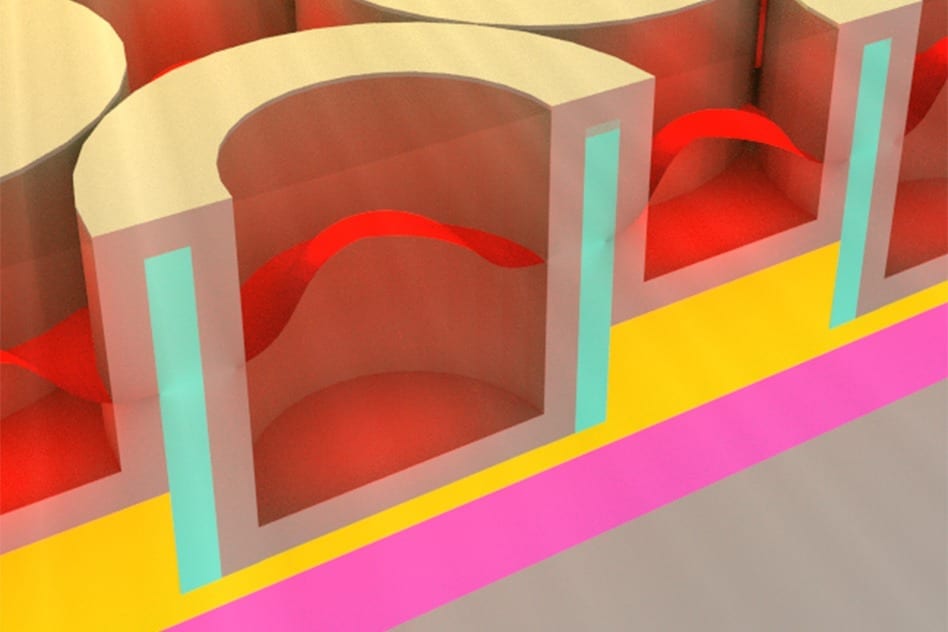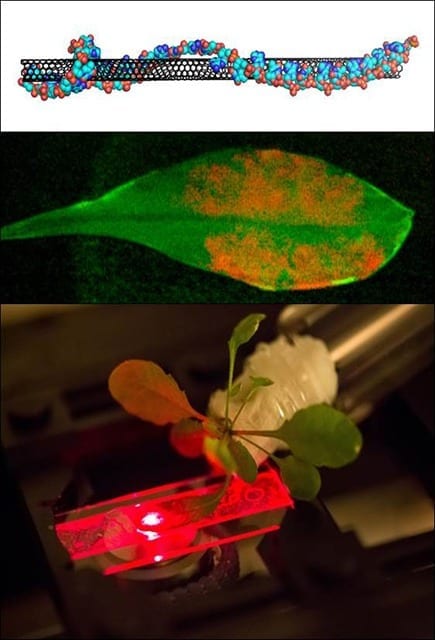
New system aims to harness the full spectrum of available solar radiation – “This is the first device that is able to do all these things at the same time”
The key to creating a material that would be ideal for converting solar energy to heat is tuning the material’s spectrum of absorption just right: It should absorb virtually all wavelengths of light that reach Earth’s surface from the sun — but not much of the rest of the spectrum, since that would increase the energy that is reradiated by the material, and thus lost to the conversion process.
Now researchers at MIT say they have accomplished the development of a material that comes very close to the “ideal” for solar absorption. The material is a two-dimensional metallic dielectric photonic crystal, and has the additional benefits of absorbing sunlight from a wide range of angles and withstanding extremely high temperatures. Perhaps most importantly, the material can also be made cheaply at large scales.
The creation of this material is described in a paper published in the journal Advanced Materials, co-authored by MIT postdoc Jeffrey Chou, professors Marin Soljacic, Nicholas Fang, Evelyn Wang, and Sang-Gook Kim, and five others.
The material works as part of a solar-thermophotovoltaic (STPV) device: The sunlight’s energy is first converted to heat, which then causes the material to glow, emitting light that can, in turn, be converted to an electric current.
Some members of the team worked on an earlier STPV device that took the form of hollow cavities, explains Chou, of MIT’s Department of Mechanical Engineering, who is the paper’s lead author. “They were empty, there was air inside,” he says. “No one had tried putting a dielectric material inside, so we tried that and saw some interesting properties.”
When harnessing solar energy, “you want to trap it and keep it there,” Chou says; getting just the right spectrum of both absorption and emission is essential to efficient STPV performance.
Most of the sun’s energy reaches us within a specific band of wavelengths, Chou explains, ranging from the ultraviolet through visible light and into the near-infrared. “It’s a very specific window that you want to absorb in,” he says. “We built this structure, and found that it had a very good absorption spectrum, just what we wanted.”
In addition, the absorption characteristics can be controlled with great precision: The material is made from a collection of nanocavities, and “you can tune the absorption just by changing the size of the nanocavities,” Chou says.
Another key characteristic of the new material, Chou says, is that it is well matched to existing manufacturing technology. “This is the first-ever device of this kind that can be fabricated with a method based on current … techniques, which means it’s able to be manufactured on silicon wafer scales,” Chou says — up to 12 inches on a side. Earlier lab demonstrations of similar systems could only produce devices a few centimeters on a side with expensive metal substrates, so were not suitable for scaling up to commercial production, he says.
In order to take maximum advantage of systems that concentrate sunlight using mirrors, the material must be capable of surviving unscathed under very high temperatures, Chou says. The new material has already demonstrated that it can endure a temperature of 1,000 degrees Celsius (1,832 degrees Fahrenheit) for a period of 24 hours without severe degradation.
And since the new material can absorb sunlight efficiently from a wide range of angles, Chou says, “we don’t really need solar trackers” — which would add greatly to the complexity and expense of a solar power system.
“This is the first device that is able to do all these things at the same time,” Chou says. “It has all these ideal properties.”
Take me to the complete story . . .
The Latest on: Solar absorber
[google_news title=”” keyword=”Solar absorber” num_posts=”10″ blurb_length=”0″ show_thumb=”left”]
via Google News
The Latest on: Solar absorber
- Solar Energy Newson April 23, 2024 at 5:00 pm
high-performance material for solar absorbers -- the central part of a solar cell that turns light into electricity. While ... Researchers Invent New Triple-Junction Tandem Solar Cells With World ...
- Best Solar Panels For Homes Of 2024on April 23, 2024 at 1:08 am
Commissions do not affect our editors' opinions or evaluations. Solar panels and their accessories unlock the boundless energy from sunshine and transform it into useful energy at home.
- Researchers design tin-germanium-based perovskite solar cell with potential efficiency of 31.49%on April 22, 2024 at 1:39 am
Researchers in Malaysia have simulated a mixed cation perovskite solar cell integrating tin and germanium in the absorber. By modulating the perovksite layer thickness, they were able to achieve an ...
- Researchers design 31%-efficient perovskite solar cell based on calcium nitrogen iodideon April 18, 2024 at 2:01 am
An international team has demonstrated a perovskite solar cell relying on inorganic calcium nitrogen iodide (Ca3NI3) perovskite and has found this absorber material offers advantages such as tunable ...
- £1.1m awarded to solar energy capture projecton April 16, 2024 at 8:28 am
The EPSRC has awarded £1.1million to a Surrey University led project, which aims to develop solar-thermal devices that can heat our homes and generate power on a larger scale.
- Project to boost solar energy capture awarded £1.1 millionon April 10, 2024 at 5:00 pm
The project has several aims: To develop solar absorbers that can work well even at very high temperatures. Improve the efficiency of the team's special solar-absorbing structures. The team plans ...
- Solar eclipse updates: When is the next total solar eclipse?on April 8, 2024 at 8:39 am
There will not be another solar eclipse in North America for 20 years. International Space Station views the eclipse A total solar eclipse passed over North America on April 8, creating a path of ...
- Solar eclipse glossaryon April 7, 2024 at 5:00 pm
The April 8, 2024, total solar eclipse will be visible across much of Mexico, the U.S. and Canada, with plenty of great locations in the path of totality. Make sure you’re prepared to speak and ...
- 2024 solar eclipse: A guide on where and how to watch iton April 6, 2024 at 5:00 pm
Sky-gazers across North America are in for a treat on April 8 when a total solar eclipse will pass over Mexico, the United States and Canada. The event will be visible to millions — including ...
- Solar chemical process developmenton April 3, 2024 at 9:31 am
solar reactors and solar absorbers, heat exchangers, special reflectors and functional materials such as redox materials and high-temperature ceramics. Reactor development for the production of ...
via Bing News










